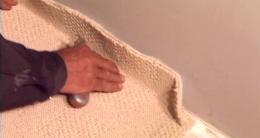Search
Login
Recommended
Do-it-yourself carpet laying
Well-laid and carefully fixed carpet - it looks beautiful and aesthetically pleasing.
Content
- Fastening carpet with carpet buttons
- Fastening carpet with double-sided tape
- Tack bar
- Docking a carpet in a doorway
- Carpet styling tool video
- Laying carpet in standard width video video
- Laying carpet on the stairs
- Method for determining the amount of carpet
Fastening carpet with carpet buttons
When laying carpet using the buttons, on each side of the carpet it is necessary to bend down a strip of width 50 mm.
Then, along this strip, every 200 mm. beat the carpet with special buttons.
In order to keep the carpet flat, there should not be bedding under the fold.
The button heads, in the future, will be closed with a pile.
Fastening carpet with double-sided tape
When attaching carpet On a rubber backing, double-sided adhesive tape (tape) is usually used.
In the process, around the perimeter of the room, stick tape 50 mm wide.
Carpet is laid out around the room, measured, made fit and only then remove the protective paper from the tape.
Carpet is pressed tightly around the perimeter of the room.
Tack bar
Tack bars have small teeth, they grab and hold the woven base of the carpet.
This mount is poorly suited for coating with a rubber backing.
When laying using tack bars, at a distance of 6 mm. from the baseboard, nail the planks to the floor so that the teeth are directed towards the wall.
If there are niches in the room - cut the trims to size, the same applies to doorways.
If the carpet is laid on a concrete floor, it is necessary to stick the planks on the floor, then the coating is cut end-to-end with each rail.
Docking a carpet in a doorway
Use door sills in the doorway.
In case of joining the carpet in the doorway, a double-sided threshold is used.
If carpet comes to an end in a doorway of a room - use a one-sided level of a threshold.
Carpet styling tool
When laying carpet, use a special tool, such as: a knee pusher, it is used to stretch the carpet.
The teeth on its tip are pressed into the carpet, pushing the emphasis of the tool with the knee, the carpet is stretched.
In addition, a stone chisel is used, with which the coating is laid, tightly stretched to each tack bar.
Necessary tool for work:
-flexible steel ruler - for cutting carpets;
-stop bar for ruler - helps with drawing right angles;
-jute-based carpet cutter;
-jute-based carpet cutter, steel;
-foam cutter for carpets;
foam cutter for carpets, steel;
-strip cutter for carpet;
universal scissors;
scissors rounded;
-clamp for screed;
-roll for a seam.
Laying carpet in standard width
If you want to lay extra bedding, secure it with pieces of tape or a few carpet buttons. Next rolled carpet
The edge of the factory trim rests against the wall and is attached to the floor.
If the coating has a pattern, it is necessary to determine the center of the room, since the pattern should be located in the direction of the main axis.
After fixing one side, the carpet is pulled towards the opposite wall and temporarily fixed with carpet buttons or tack bars.
Do not cut the cover, pull and fix the carpet from the middle to the corners.
In order for the carpet to lie without folds, make a triangular incision in each corner.
After that, when the coating will lie flat - fix it permanently.
When using tack bars or scotch tape, you can press the carpet into the corner between the baseboard and the floor using a stone chisel.
The edge is trimmed by holding the knife at an angle of 45 degrees to the baseboard, then push the edge over the bar with a chisel.
If it is necessary to join the carpeting, glue straight seams with latex glue, and if the coating has a rubber backing, use adhesive tape.
Expensive carpets with a woven pile are recommended to be sewn to a specialist.
Laying carpet on the stairs
To lay carpet on the stairs, use a narrow carpet or walkway with a margin of 45 cm in length.
Subsequently, the track can be moved to mask worn places.
This allowance for future repairs is bent at the bottom step.
When laying the cover, the pile of the carpet should be directed towards the descent.
If the staircase has beautiful steps, the edges can be left uncovered, in which case, the carpet is attached to the risers with rods. The cover can be fixed with carpet buttons along the treads every 75 mm.
First, nail the middle, press the carpet firmly against the corner between the riser and the tread, continue to fasten moving to the edges.
Can be fixed with tack bars, but if the backing is not rubber.
1. bedding 2. carpet down 3. nailed to the riser 4. fixed with a tack bar.
If you want to lay the litter, cut into sections for each tread, fasten each section with buttons or a tack bar at the riser, and in front under the overhang, tread.
When laying carpet, lay the carpet on the first tread from the bottom, face down, fasten the trailing edge with the buttons or nail the bar.
Then, pull the carpet around the overhang and secure it at the bottom of the riser, nailing through the tack bar.
Using a stone chisel, tightly pull the cover onto each tack bar, nail the end of the carpet to the riser of the last tread, and put the end of the landing onto the upper step and connect it to the staircase cover.
Method for determining the amount of carpet
Before going to the flooring store, draw a plan of the room, including the location of doors, window niches, the full width of the door frame. Indicate all sizes on the plan and take it with you.
When buying a carpet you will be prompted the most economical way for this room.
The ideal option is seamless flooring, wall to wall. But this, a fluke, is very rare. Often, this is not possible due to the lack of the required width, or due to the complex floor configuration of the room.
Sometimes when using one piece, too many scraps are obtained and this can significantly increase the cost of coverage. In such cases, it is necessary to join pieces of carpet. Try not to make a seam in places of the main movement, it is good if it is located, for example, under upholstered furniture.
Consider the direction of the pile on the parts of the coating, otherwise they will look different, pay attention to the selection of the pattern, do not forget to leave an allowance of 75 mm. on all sides, which is necessary for fitting in place and laying.
Most manufacturers produce carpet in standard widths.
A product with a width of 2.74 meters or more, is usually called carpets or carpets, 0.91 meters wide and less - carpet tracks.





